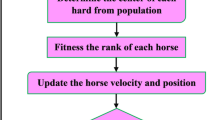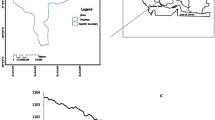Abstract
Evaporation is one of the key factors in the hydrological cycle, and it is one of the most critical parameters in hydrological, agricultural, and meteorological studies, especially in arid and semi-arid regions. By estimating evaporation, it is possible to make a significant contribution to studies related to water balance, management and design of irrigation systems, estimation of crop amount, and management of water resources. In this regard, in the present study, using artificial neural network (ANN) and its hybrid algorithms including Harris Hawks Optimization (HHO), Whale Optimization Algorithm (WOA), and Particle Swarm Optimization (PSO), the daily evaporation value from the reservoir of Qaleh Chay Ajab Shir dam was estimated. For this purpose, the effective parameters in the evaporation process were introduced to each of the models in the form of different input patterns, and the evaporation value from the reservoir was also considered as output parameter. The results showed that the best selected model for ANN is the P3 model including three parameters of minimum air temperature, and daily evaporation data with NASH of 0.89, RMSE of 1.5 mm/day, and MAE of 1.1 mm/day, which was optimized by applying hybrid algorithms to train the neural network. The results disclosed that all three models had a good performance in estimating the daily evaporation value, so that the value of the correlation coefficient for all three models is in the range of 0.95–0.99. Based on evaluation criteria, ANN–HHO has better performance than the two other algorithms in estimating daily evaporation value. The values of NASH, RMSE and MAE for the selected pattern of the test data are 0.943, 0.908 and 0.736 mm/day, respectively. For better analysis, Taylor diagram is used (RMSD = 0.98, CC = 0.97, STD = 4 for ANN–HHO). The results of this diagram also showed that the ANN–HHO model provides acceptable performance when compared with other models. Considering the promising results of the models in predicting the daily evaporation from dam, it is suggested to use the existing approach for landscaping the groundwater balance and design of irrigation systems.












Similar content being viewed by others
Explore related subjects
Discover the latest articles, news and stories from top researchers in related subjects.References
Adib A, Mahmoodi A (2017) Prediction of suspended sediment load using ANN GA conjunction model with Markov chain approach at flood conditions. KSCE J Civ Eng 21(1):447–457
Agatonovic-Kustrin S, Beresford R (2000) Basic concepts of artificial neural network (ANN) modeling and its application in pharmaceutical research. J Pharm Biomed Anal 22(5):717–727
Allawi MF, Aidan IA, El-Shafie A (2021) Enhancing the performance of data-driven models for monthly reservoir evaporation prediction. Environ Sci Pollut Res 28(7):8281–8295
Ashrafzadeh A, Kisi O, Aghelpour P, Biazar SM, Masouleh MA (2020) Comparative study of time series models, support vector machines, and GMDH in forecasting long-term evapotranspiration rates in northern Iran. J Irrig Drain Eng 146(6):04020010
Ashrafzadeh A, Malik A, Jothiprakash V, Ghorbani MA, Biazar SM (2018) Estimation of daily pan evaporation using neural networks and meta-heuristic approaches. ISH J Hydraul Eng. https://doi.org/10.1080/09715010.2018.1498754
Azar NA, Milan SG, Kayhomayoon Z (2021) The prediction of longitudinal dispersion coefficient in natural streams using LS-SVM and ANFIS optimized by Harris hawk optimization algorithm. J Contam Hydrol 240:103781
Biazar SM, Ferdosi FB (2020) An investigation on spatial and temporal trends in frost indices in Northern Iran. Theoret Appl Climatol. https://doi.org/10.1007/s00704-020-03248-7
Biazar SM, Dinpashoh Y, Singh VP (2019) Sensitivity analysis of the reference crop evapotranspiration in a humid region. Environ Sci Pollut Res 26(31):32517–32544. https://doi.org/10.1007/s11356-019-06419-w
Bruton JM, McClendon RW, Hoogenboom G (2000) Estimating daily pan evaporation with artificial neural networks. T Asae 43(2):491–496
Brutsaert WH (1982) Evaporation into the Atmosphere. D. Reidel, Dordrecht, p 299
Clerc M, Kennedy J (2002) The particle swarm-explosion, stability, and convergence in a multidimensional complex space. IEEE Trans Evol Comput 6(1):58–73
Dang NM, Tran Anh D, Dang TD (2019) ANN optimized by PSO and Firefly algorithms for predicting scour depths around bridge piers. Eng Comput 35:1–11
Dogan E, Isik S, Sandalci M (2007) Estimation of daily evaporation using artificial neural networks. Tek Dergi 18(2):4119–4131
Dorigo M (1992) Optimization, learning and natural algorithms. PhD thesis. Politecnico di Milano, Italy
Floudas CA, Pardolos PM (2009) Encyclopedia of optimization, 2nd edn. Springer, Heidelberg
Eberhart R, Kennedy J (1995) Particle swarm optimization. Proc IEEE Int Conf Neural Netw 4:1942–1948
Ghorbani MA, Deo RC, Yaseen ZM, Kashani MH, Mohammadi B (2018) Pan evaporation prediction using a hybrid multilayer perceptron-firefly algorithm (MLP-FFA) model: case study in North Iran. Theoret Appl Climatol 133(3):1119–1131
Goyal MK, Bharti B, Quilty J, Adamowski J, Pandey A (2014) Modeling of daily pan evaporation in sub-tropical climates using ANN, LS-SVR, Fuzzy Logic, and ANFIS. Expert Syst Appl 41(11):5267–5276
Guo Y, Zhang Y, Ma N, Xu J, Zhang T (2019) Long-term changes in evaporation over Siling Co Lake on the Tibetan Plateau and its impact on recent rapid lake expansion. Atmos Res 216:141–150. https://doi.org/10.1016/j.atmosres.2018.10.006
Haghnegahdar L, Wang Y (2020) A whale optimization algorithm-trained artificial neural network for smart grid cyber intrusion detection. Neural Comput Appl 32(13):9427–9441
Hastie T, Tibshirani R, Friedman J (2009) The elements of statistical learning: data mining inference and prediction, 2nd edn. California, Springer
Haykin S (1999) Neural network and its application in IR, a comprehensive foundation, Upper Saddle Rever. Prentice Hall, New Jersey, p 842 (13, 775–781)
Heidari AA, Mirjalili S, Faris H, Aljarah I, Mafarja M, Chen H (2019) Harris hawks optimization: algorithm and applications. Futur Gener Comput Syst 97:849–872
Holmes TR (2019) Remote sensing techniques for estimating evaporation. In extreme hydroclimatic events and multivariate hazards in a changing environment. Elsevier, Amsterdam, pp 129–143
Jackson RD (1985) Evaluating evapotranspiration at local and regional scales. Proc IEEE 73(6):1086–1096
Karimi-Googhari S (2010) Daily pan evaporation estimation using a neuro-fuzzy based model. Trends Agric Eng 2010:191–195
Karkheiran S, Kabiri-Samani A, Zekri M, Azamathulla HM (2019) Scour at bridge piers in uniform and armored beds under steady and unsteady flow conditions using ANN-APSO and ANN-GA algorithms. ISH J Hydraul Eng 25:1–9
Keskin ME, Terzi O (2006) Artificial neural network models of daily pan evaporation. J Hydrol Eng 11(1):65–70
Kim S, Kim HS (2008) Neural networks and genetic algorithm approach for nonlinear evaporation and evapotranspiration modeling. J Hydrol 351(3–4):299–317
Kim S, Singh VP, Seo Y (2014) Evaluation of pan evaporation modeling with two different neural networks and weather station data. Theoret Appl Climatol 117(1–2):1–13
Kiran NR, Ravi V (2008) Software reliability prediction by soft computing techniques. J Syst Softw 81(4):576–583
Kirkpatrick S, Gellat CD, Vecchi MP (1983) Optimization by simulated annealing. Science 220:670–680
Kisi O, Cimen M (2011) A wavelet-support vector machine conjunction model for monthly streamflow forecasting. J Hydrol 399:132–140
Kisi O (2005) Discussion of ‘“Fuzzy logic model approaches to daily pan evaporation estimation in western Turkey.”’ Hydrol Sci J 50(4):727–728
Kisi O (2006) Daily pan evaporation modelling using a neuro-fuzzy computing technique. J Hydrol 329(3–4):636–646
Kisi O (2009) Daily pan evaporation modelling using multi-layer perceptrons and radial basis neural networks. Hydrol Process 23(2):213–223
Makridakis S, Andersen A, Carbone R, Fildes R, Hibon M, Lewandowski R, Winkler R (1982) The accuracy of extrapolation (time series) methods: results of a forecasting competition. J Forecasting 1(2):111–153
Malik A, Kumar A (2015) Pan evaporation simulation based on daily meteorological data using soft computing techniques and multiple linear regression. Water Resour Manage 29(6):1859–1872
Milan SG, Roozbahani A, Azar NA, Javadi S (2021) Development of adaptive neuro fuzzy inference system–evolutionary algorithms hybrid models (ANFIS-EA) for prediction of optimal groundwater exploitation. J Hydrol 598:126258
Mirjalili S, Lewis A (2016) The whale optimization algorithm. Adv Eng Softw 95:51–67
Moayedi H, Gör M, Lyu Z, Bui DT (2020) Herding Behaviors of grasshopper and Harris hawk for hybridizing the neural network in predicting the soil compression coefficient. Measurement 152:107389
Moghaddamnia A, Gosheh MG, Nuraie M, Mansuri MA, Han D (2010) Performance evaluation of LLR, SVM, CGNN and BFGSNN models to evaporation estimation. Energy Environ Eng S 5:108–113
Najafzadeh M, Tafarojnoruz A, Lim SY (2017) Prediction of local scour depth downstream of sluice gates using data-driven models. ISH J Hydraul Eng 23(2):195–202
Nourani V, Elkiran G, Abdullahi J (2019) Multi-station artificial intelligence based ensemble modelling of reference evaporationspiration using pan evaporation measurements. J Hydrol 577:1–20
Nourani V, Sayyah Fard M (2012) Sensitivity analysis of the artificial neural network outputs in simulation of the evaporation process at different climatologic regimes. Adv Eng Softw 47(1):127–146
Piri J et al (2009) Daily pan evaporation modeling in a hot and dry climate. J Hydrol Eng 14(8):803–811
Samadianfard S, Hashemi S, Kargar K, Izadyar M, Mostafaeipour A, Mosavi A et al (2020) Wind speed prediction using a hybrid model of the multi-layer perceptron and whale optimization algorithm. Energy Rep 6:1147–1159
Sammen SS, Ghorbani MA, Malik A, Tikhamarine Y, AmirRahmani M, Al-Ansari N, Chau KW (2020) Enhanced artificial neural network with harris hawks optimization for predicting scour depth downstream of ski-jump spillway. Appl Sci 10(15):5160
Samui P, Dixon B (2012) Application of support vector machine and relevance vector machine to determine evaporative losses in reservoirs. Hydrol Process 26(9):1361–1369
Sanikhani H, Kisi O, Nikpour MR, Dinpashoh Y (2012) Estimation of daily pan evaporation using two different adaptive neuro-fuzzy computing techniques. Water Resour Manage 26(15):4347–4365
Seifi A, Riahi H (2018) Estimating daily reference evapotranspiration using hybrid gamma test-least square support vectormachine, gamma test-ANN, and gamma test-ANFIS models in an arid area of Iran. J Water Clim Change. https://doi.org/10.2166/wcc.2018.003
Sharifan H, Ghahreman B, Alizadeh A, Mirlatifi SM (2006) Comparion of the different methods of estimated reference evapotranspiration (compound and temperature) with standard method and analysis of aridity effects. J Agric Sci Nat Resour 13:19–30 (In Persian)
Sudheer KP, Gosain AK, Mohana Rangan D, Saheb SM (2002) Modelling evaporation using an artificial neural network algorithm. Hydrol Process 16(16):3189–3202
Talbi EG (2009) Metaheuristics: from design to implementation. Wiley, Chichester
Terzi Ö, Keskin ME (2008) Comparison of artificial neural networks and empirical equations to estimate daily pan evaporation. Irrigat Drain. https://doi.org/10.1002/ird.454
Tikhamarine Y, Malik A, Kumar A, Souag-Gamane D, Kisi O (2019) Estimation of monthly reference evapotranspiration using novel hybrid machine learning approaches. Hydrol Sci J 64(15):1824–1842
Tran-Ngoc H, Khatir S, Ho-Khac H, De Roeck G, Bui-Tien T, Wahab MA (2021) Efficient Artificial neural networks based on a hybrid metaheuristic optimization algorithm for damage detection in laminated composite structures. Compos Struct 262:113339
Vaheddoost B, Kocak K (2019) Temporal dynamics of monthly evaporation in Lake Urmia. Theoret Appl Climatol 137(3–4):2451–2462. https://doi.org/10.1007/s00704-018-2747-3
Wang B, Ma Y, Ma W, Su B, Dong X (2018) Evaluation of ten methods for estimating evaporation in a small high-elevation lake on the Tibetan Plateau. Theoret Appl Climatol. https://doi.org/10.1007/s00704-018-2539-9
Wang W, Lee X, Xiao W, Liu S, Schultz N, Wang Y et al (2018) Global lake evaporation accelerated by changes in surface energy allocation in a warmer climate. Nat Geosci 11(6):410. https://doi.org/10.1038/s41561-018-0114-8
Yang XS (2008) Nature-inspired metaheuristic algorithms. Luniver Press
Yang XS, Deb S (2010) Engineering optimization by cuckoo search. Int J Math Modell Num Optimiz 1(4):330–343
Zhao G, Gao H (2019) Estimating reservoir evaporation losses for the United States: fusing remote sensing and modeling approaches. Remote Sens Environ 226:109–124. https://doi.org/10.1016/j.rse.2019.03.015
Zhou Y, Niu Y, Luo Q, Jiang M (2020) Teaching learning-based whale optimization algorithm for multi-layer perceptron neural network training [J]. Math Biosci Eng 17(5):5987–6025
Author information
Authors and Affiliations
Corresponding author
Additional information
Publisher's Note
Springer Nature remains neutral with regard to jurisdictional claims in published maps and institutional affiliations.
Rights and permissions
About this article
Cite this article
Arya Azar, N., Kardan, N. & Ghordoyee Milan, S. Developing the artificial neural network–evolutionary algorithms hybrid models (ANN–EA) to predict the daily evaporation from dam reservoirs. Engineering with Computers 39, 1375–1393 (2023). https://doi.org/10.1007/s00366-021-01523-3
Received:
Accepted:
Published:
Issue Date:
DOI: https://doi.org/10.1007/s00366-021-01523-3




